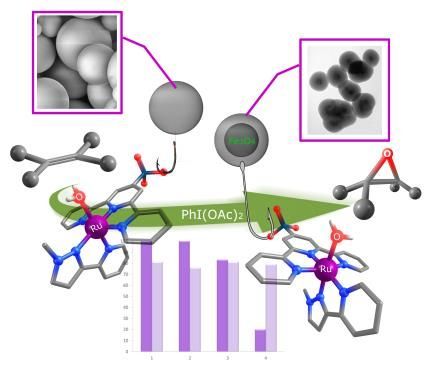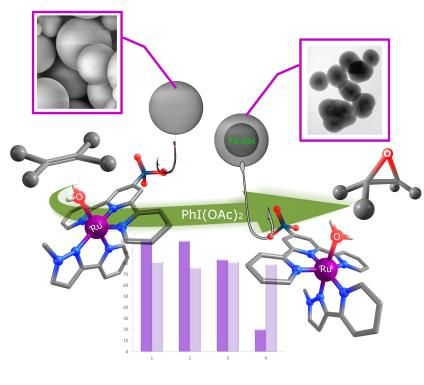
First accepted manuscript of 2017, in CHEMISTRY – A European Journal

A recent manuscript entitled “A recoverable ruthenium aqua complex supported onto silica particles: an efficient epoxidation catalyst“, by M. Isabel Romero, Ingrid Ferrer, Xavier Fontrodona, Anna Roig and Montserrat Rodríguez, has been accepted in CHEMISTRY – A European Journal (Accepted manuscript online: 11 January 2017; D
This article is the product of a collaboration with the Group of Catalysis and Sustainability of the University of Girona.
The article reports the synthesis and catalytic performance of hybrid materials formed by a molecular ruthenium aqua complex anchored onto silica mesoporous and silica coated magnetic particles. The catalytic results and the reutilization of these hybrid materials highlight their performance in the epoxidation of alkenes.
Abstract
The preparation and characterization of new complexes with a phosphonated trpy ligand (trpy-P-Et) and a bidentate pyridylpyrazole (pypz-Me) ligand, with formula [RuII(trpy-P-Et)(pypz-Me)X]n+ (X = Cl, n= 1, 2; X=H2O, n=2, 3) is described, together with the anchoring of 3 onto two types of supports: mesoporous silica particles (SP) and silica coated magnetic particles (MSP). The aqua complex 3 is easily obtained through reflux of 2 in water and displays a bielectronic Ru(IV/II) redox process. It has been anchored onto SP and MSP supports through two different synthetic strategies, yielding the heterogeneous systems SP@3 and MSP@3 that have been fully characterized by IR, UV-vis, SEM, CV and DPV. Catalytic olefin epoxidation has been tested with the molecular complex 3 and the SP@3 and MSP@3 heterogeneous counterparts, including the reuse of the heterogeneous systems. The MSP@3 material can be easily recovered by a magnet facilitating their reusability.
Download article.
accepted paper, catalysis, magnetic nanoparticles, mesoporous silica, publication, recover, ruthenium, silica nanoparticles, sustainability

